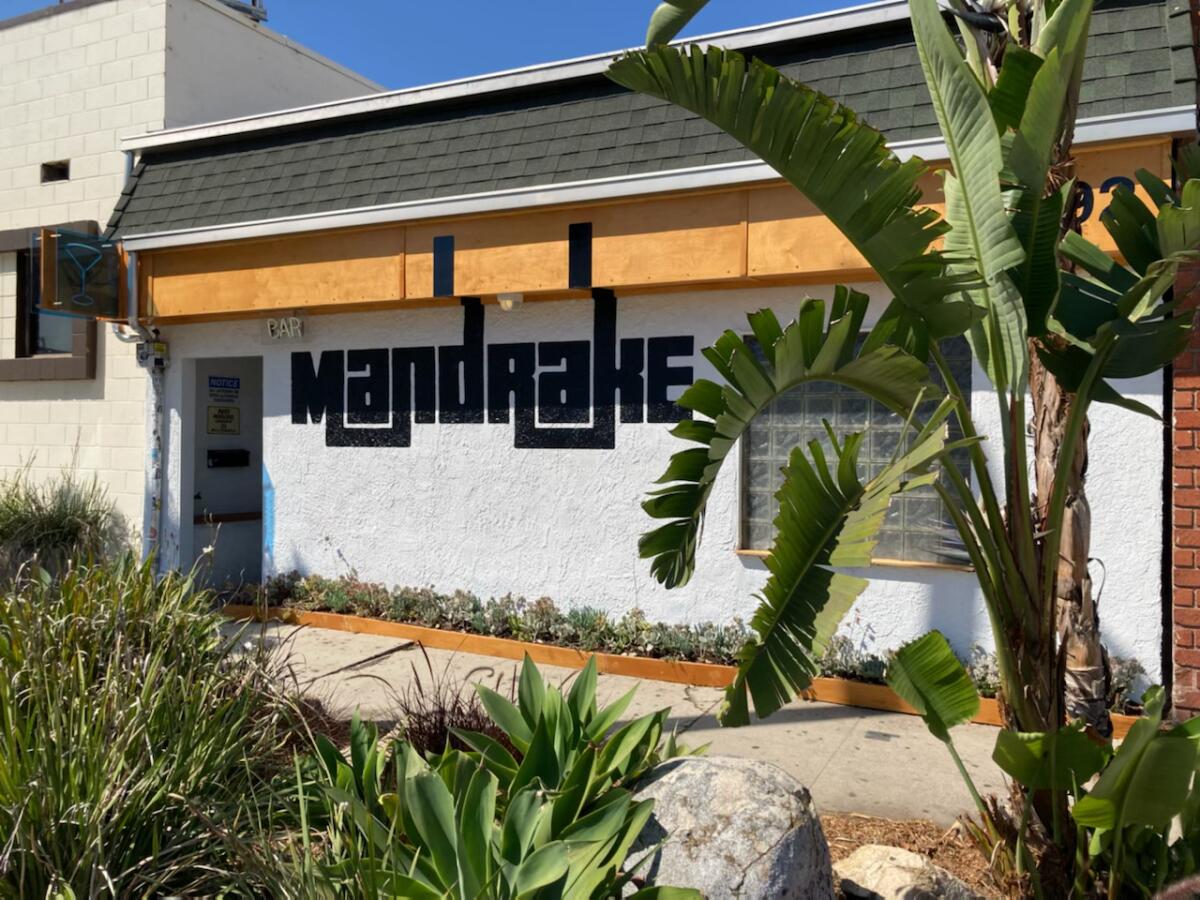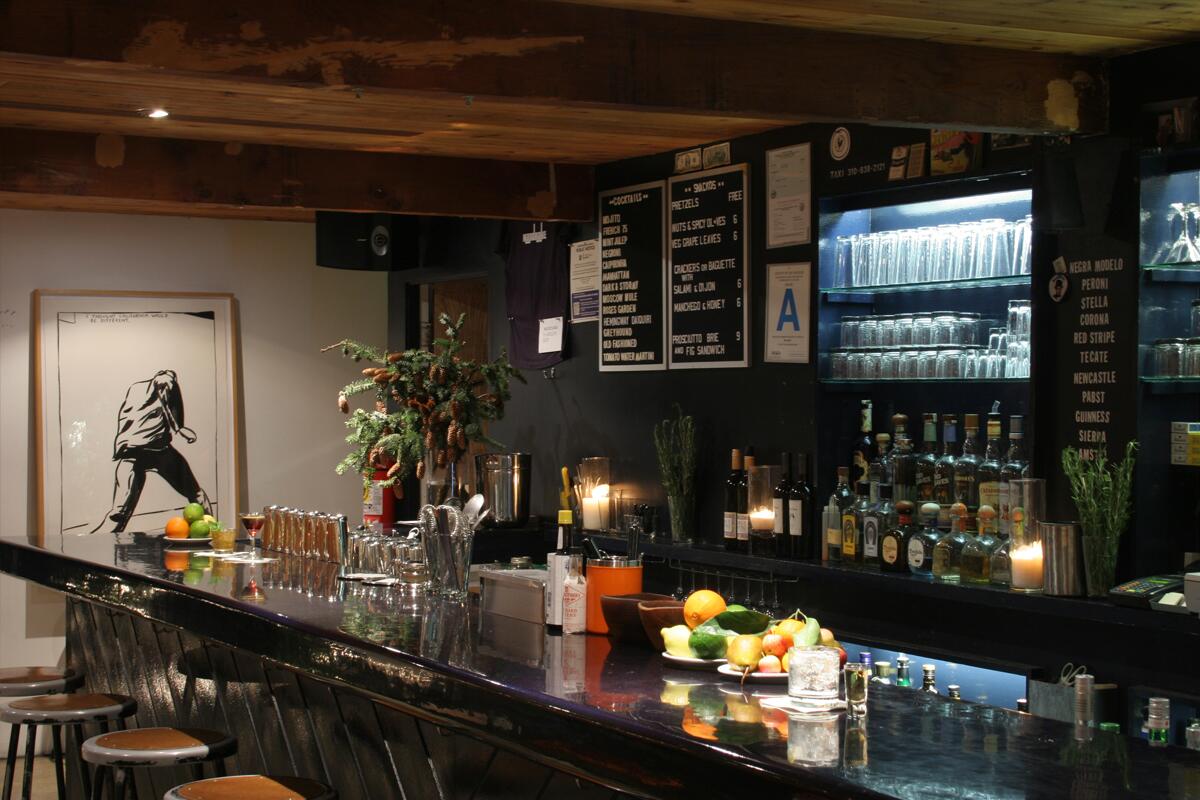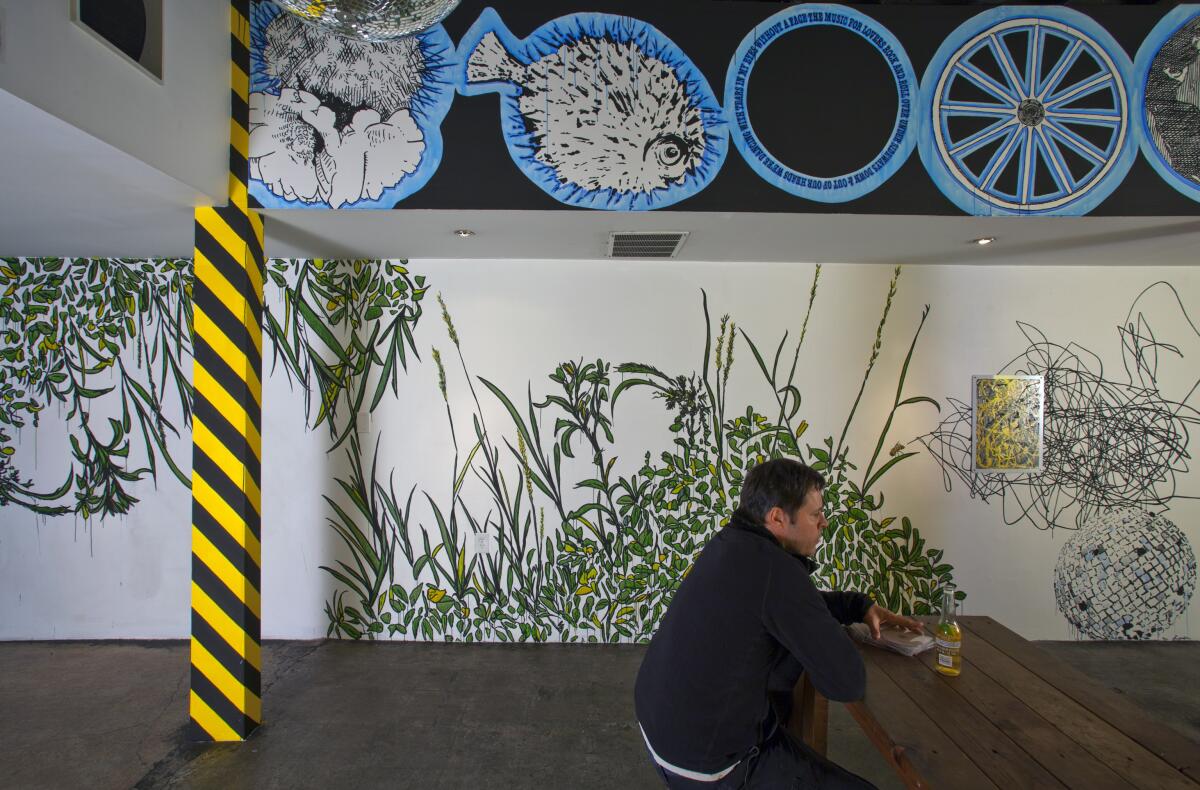The closure of Culver City’s arts-driven Mandrake Bar marks ‘the end of an era’

- Share via
On a busy section of La Cienega Boulevard at the edge of Culver City, bordering Pico-Robertson and Mid-City, Mandrake can be easy to miss. The bar is tucked between nondescript art galleries and auto repair shops, with a blinking, white neon martini-shaped sign that guides you to its narrow entryway.
Opened by Flora Wiegmann, Drew Heitzler and Justin Beal in 2006, the clandestine drinking den was transformed into a thriving hub for local artists. With creative programming — such as readings, video installations and art exhibits — and eccentric aesthetics including handmade cabinetry, original art and lacquered tree-ring tables, Mandrake helped solidify Culver City’s just-blossoming Arts District as a destination.
After 18 years of service, Mandrake Bar announced on Monday via Instagram its plans to close to make way for a new bar concept that’s set to open in April. Its last day of business will be March 16.
“The end of an era,” the Instagram post began. “We are proud of the reputation Mandrake was able to build and maintain over the years as well as the community it was able to generate. Everything has a time and place and Mandrake will be remembered fondly for occupying her time and place perfectly.”
The bar’s past patrons echoed the sentiment in the comments section, celebrating Mandrake as “one of the least pretentious bars with the best drinks” and reminiscing on “core memories of lifetimes gone by.”
Wiegmann, who spoke to The Times by phone, cited major life changes as the driving decision behind closing the bar. Since the pandemic, she has been working remotely from the tiny, unincorporated town of Lopez Island in Washington state. Beal relocated to New York and Heitzler is a recent father.
The three of them were all practicing artists when they opened the bar in 2006. Wiegmann and Heitzler, who have backgrounds in dance and visual arts, respectively, had been running an art gallery in an apartment just behind the bar on Comey Avenue. Beal, who is a visual artist with an architecture degree, worked with Heitzler as an art handler. After seeing the bar space sit empty on La Cienega for more than a year, they decided to partner to take over the lease.

Wiegmann had spent years working in restaurants and bars, as it offered her the flexibility to take dance classes and perform, and also had management experience from time spent in New York. Heitzler had briefly worked at CBGB, the iconic, now-closed punk bar in New York City.
“We had all these skills that really just sort of came together and allowed us to create a space that was a bit of a combination of everything we all did,” says Wiegmann.
The three had established roots in the neighborhood but didn’t have the funds to open the bar on their own. In addition to lining up support from family members, they found several investors from the local arts community, including Tim Blum of Blum Gallery just across the street.
Blum told The Times, “Certainly, the closing of Mandrake marks another transition in a year of transitions. Mandrake was a central force during a very specific time in the Los Angeles art scene for which we are forever grateful. The influence it had was incalculable. Anecdotally, the naming of the bar was a monumental art-world contest. Curator Ann Goldstein, previously of the Museum of Contemporary Art and now at the Art Institute of Chicago, came up with the name.”
In its first few years, Mandrake operated almost like a gallery, with the room between the front bar and the outdoor patio hosting rotating art shows. As the bar became more popular, artwork was damaged and programming shifted to book launches, film screenings and DJ sets.
Wiegmann, Heitzler and Beal also made a point of hiring from their community of artists.
“For me, it gave me greater insight into what the journey of an artist can entail,” says G.L. Askew II, a photographer and filmmaker who was a bartender at Mandrake for five years. He says he never felt pressured to choose between his job and his art, and that it was a rare space where staff could be open about what they were pursuing in their off-time. The position also introduced him to key players in L.A.’s art world.
Mandrake didn’t just elevate big-name artists. Yohan Serrant had practically no DJ experience when he approached the bar with the idea to host a residency. After a successful opening night, Bashment Boogie, an evening dedicated to African and Caribbean music, was born. The residency ran every third Saturday night for two years.
“We’ve always erred on the side of giving people autonomy and letting them guide where the bar is going,” Wiegmann says.

As the galleries in Culver City’s Arts District gradually dispersed to different neighborhoods, Mandrake found a new audience with nearby tech and postproduction workers. Wiegmann describes 2019 as the bar’s “best year ever,” with crowds that lasted from postwork happy hour until late night.
During pandemic closures, the bar pivoted to a general-store model. The three partners reached out to former art connections and stocked the space with everything from records sold through a company owned by one of their bartenders to ceramics, plants and bar kits. They used the pause to reimagine the bar’s design and installed personal artwork that is still on display, including a lamp by Beal.
But Mandrake never fully recovered after reopening. “Drinking culture changed,” says Wiegmann. With so many people working from home, the once-bustling happy hour stalled.
“I honestly think we just didn’t have any more transformations left in us,” Wiegmann says. She references the bar’s legacy as a former gay leather joint and Irish pub, saying, “There’s this history of this building being passed forward, and it was time for us to realize that someone else can take it on and someone else can make something new.”
Shin Irvin, owner of Shin’s Pizza in Cypress Park, and Ben Rojo, who managed several bars in New York City, are taking over the building’s lease. According to Wiegmann, the pair are longtime fans of Mandrake and don’t plan to change its comfortable feel. The bar concept will be called No Smoking and is set to open in April. She’s hopeful that the new bar will retain most of the existing staff.
On the first Tuesday since announcing its closure, Mandrake was drawing happy hour crowds that spilled across the front bar, lounge area and bougainvillea-lush patio. Working alone, at first bartender Rose Finn couldn’t say for sure whether it was any busier than usual. “It’s very random here,” she says.
By 9:30 p.m., a second bartender had arrived to help Finn. The din of clashing conversations obscured an R&B soundtrack that played softly in the background. Finn retracted her statement, saying, “I think people saw that the bar is closing and wanted to experience it one last time.”
Mandrake is open from Tuesday through Saturday until March 16, with a daily happy hour from 5 to 8 p.m.
More to Read
Eat your way across L.A.
Get our weekly Tasting Notes newsletter for reviews, news and more.
You may occasionally receive promotional content from the Los Angeles Times.









